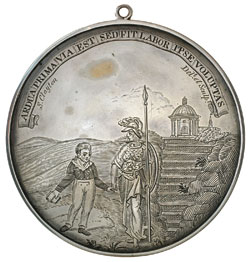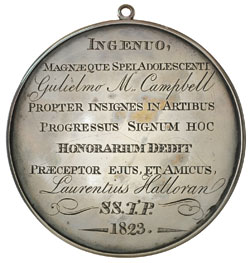Australian Historical Medals (1788-1885)
Lot 705 SESSION 3 (John Chapman Collection, 2.30pm Tuesday) Australian Historical Medals (1788-1885)
Estimate $20,000
Bid at live.noble.com.au
SOLD $26,000
THE HALLORAN SCHOOL MEDAL, 1823, in silver (72mm) with loop suspender, by Samuel Clayton, obverse, an allegorical scene of Minerva leading a schoolboy, the temple of Fame and a church in the background, legend, Ardua prima via est sed fit labor ipse voluptas (At first the way is hard but labour itself becomes a pleasure) and signed 'S.Clayton Delt. et. Sculpt.', reverse, legend, Ingenuo magnaeque spei adolescenti / Guiliemo M. Campbell / Prpter insignes in Artibus / Progressus signum hoc / Honorarium dedit / Praeceptor ejus, et amicus / Laurentius Halloran / SS.T.P. / 1823 (upright young man of great future, William Campbell, on account of his distinguished progress on his studies, his teacher and friend Lawrence Halloran gave this mark of honour SS.T.P.1823). Extremely fine and very rare, amongst the earliest of Australian medals extant having been executed by the finest silversmith in the colony at the time.
Ex Spink Australia Sale 24 (lot 1018). This is now the fifth of these medals to be discovered, the others being awarded to Robert Campbell (dated 1819), Francis Lord (1822), Charles Driver (1823) and Henry Halloran (1824). The Sydney Gazette of 15th July 1820 records 'On Friday ult. the half yearly exhibitions of the various exercises by Dr Halloran's pupils took place at his house in Phillip Street, and the Latin class underwent a public examination in their classical studies. To those who are appraised of Dr Halloran's long experience as a teacher, and of the number of persons now filling eminent situations who were educated by him, it will scarcely be necessary to say that his pupils acquirements in the short period during which they have studied under his directions, appeared highly creditable to themselves and their instructor. Handsome silver medals of considerable value were presented to Masters Henry Robinson and John Wile'... 'Similar medals were obtained at Christmas last by Francis Lord and Robert Campbell'. Another entry in the Sydney Gazette, dated 22nd December 1821 states 'Silver medals were awarded by their Reverend Tutor as follows: one to Master John Piper and the other to Master John Terry'. Lawrence Hyres Halloran was born on 29 December 1765 in Raroath, County Meath, Ireland. He was orphaned in 1772, placed in the care of his uncle, Judge William Gregory, and educated at Westminister School and later at the Royal Mathematics School attached to Christ's Hospital which specialised in navigation. He entered the Navy in 1780 but deserted some two and a half years later after killing a midshipman with a sword. He was tried for murder at the Exeter Assizes in 1783 and was acquitted. In 1785 he opened a grammar school at Alphington near Exeter which he ran with great success for twelve years. A silver medal with a similar allegorical scene to the present one awarded to a pupil of the school in 1794, is illustrated in 'Silver Medals, Badges and Trophies from Schools in the British Isles 1550-1850' by M.E.Grimshaw (Cambridge, n.d.) page 21. Obviously the design by the Exeter silversmiths H. and J. Sweet was to Halloran's liking for him to ask Clayton to reproduce it some twenty five years later. The school must have had a good reputation as it was responsible for the education of the future Lord Gifford, Master of the Rolls. Whilst at the school Halloran married Lydia Anne Hall who eventually bore him twelve children. He changed his religion from Catholic to Church of England in 1796, took Holy Orders and rejoined the Navy, this time as Chaplain, in 1798. Two years later he submitted himself as a candidate for the honorary degree of doctor of divinity at King's College, Aberdeen for which he was accepted but it would appear that he never completed the doctorate. His naval career included being present by the Battle of Trafalgar (21st October 1805) and concluded whilst chaplain to the naval and military forces at the Cape of Good Hope, a job he undertook between 1807 and 1810. In the later years he ran foul of the commander of the forces General H.C.Grey, by defending two officers charged with duelling and by subsequently disobeying an order to proceed as chaplain to the outpost at Simonstown. In June of that year he resigned his commission and published several poems which were highly libellous. Grey insisted that the Governor prosecute Halloran and the ensuing case found him guilty of defamatory libel. He was heavily fined, had costs charged against him and banished from the colony. He returned to London with no money, no job and apparently no family. Between 1811 and 1817 he wandered the length and breadth of the country trying to find employment. He was handicapped however, by a sense of persecution and a passion for litigation. Eventually he turned to forging letters in order to gain employment as a curate and was caught. The authorities found in his possession a 'copper plate for making impressions of Deacons' and Priests' orders, together with impressions of the plate on parchment ... two other copper plates for letters of orders for the Kingdom of Ireland and seals engraved on stone and metal which had been used by him at various times including one used by him on the letter bearing the forged frank'. He was charged with forging a temporary frank of Sir William Garrow M.P., allegedly for the purpose of accrediting himself as a curate. He was found guilty and sentenced to seven years transportation. He arrived in Sydney on the transport 'Baring' in June 1819 finding in the town John Thomas Campbell, a friend from his days in South Africa, who held the post of Vice-regal Secretary. It was on Campbell's recommendation that Macquarie issued Halloran a ticket of leave soon after his arrival that was later rescinded. Halloran was assigned as a servant to Simeon Lord, who, with John Macarthur, helped him establish a private school (The Sydney Free Public Grammar School) which opened in late 1819 and was quickly patronised by the leading emancipists in Sydney. Halloran's standard of education can not be questioned: Macquarie said that he was 'the best and most admired instructor of youth in the Colony' and J.T.Bigge had to admit that the standard of his school 'added one more to the many proofs that have been exhibited of Halloran's skill in the art of instruction' although he deplored the employment of a convicted forger. In 1822 Halloran's family came out to Sydney but his wife died a year after the birth of their twelfth child. He married Elizabeth Turnbull, aged 17, in August 1824, who bore him several children. Halloran's obsessive sense of persecution and his penchant for writing libellous tracts kept him constantly involved in litigation and was primarily responsible for his pecuniary troubles. In order to escape the endless creditors he moved his school frequently but this did not prevent several spells in jail. In 1825 he proposed the establishment of a public grammar school under the patronage of the governor (then Brisbane) and managed by thirty trustees each of whom could nominate a pupil with a subscription of fifty pounds. A land grant and payments from the police fund were suggested as sources of income and the headmaster was to take twenty pupils on his own terms. Every three years the government was to send two outstanding graduates to Oxford or Cambridge after which they were to take holy orders before returning to the colony. In November 1825 the school opened in temporary quarters with Halloran as the headmaster and his eldest son as undermaster. It took only a month before the trustees found cause to reprimand Halloran for his litigious behaviour and within four months to investigate complaints of unseemly behaviour which had been made against the son. In October 1826 the trustees resolved to suspend the running of the school at the end of the year citing the need to use their limited funds to build a permanent structure but Halloran's imprisonment for debt in November must have persuaded the trustees to start afresh. He re-opened his private school in January 1827 and on the 5th April he published the first issue of the 'Gleaner'. The paper was not a success and Halloran's propensity for attracting libel suits against him along with his limited business knowledge caused it to be shut down on 29th September. In 1828, Governor Darling took pity on him and appointed him coroner for Sydney but had to dismiss him when he threatened to publish a defamation of Archdeacon Scott with whom he had fallen out. In 1830 Halloran tried his hand at drawing up memorials for persons with grievances. He died in Sydney on 8th March 1831. References: 'Australian Dictionary of Biography', Vol 1, p.506-7 (A.G.Austin). 'ANS Journal 1982', Sydney Grammar School Medal 1819-1824, by L.Carlisle, p.2-10. 'Silver Medals, Badges and Trophies from Schools in the British Isles 1550-1850' by M.E.Grimshaw.
Estimate / sale price does not include buyer's premium (currently 22% including GST) which is added to hammer price. All bids are executed on the understanding that the Terms & Conditions of sale have been read and accepted. For information on grading and estimates please refer to the Buying at Auction advice.
Quick find
View a lot by number and sale.
Adjacent lots
Lot 703
GOLD SPECIMEN IN QUARTZ (2), gross weight 38gms, gold content 4gms, gross weight 60.25gms, gold ...
Estimate $900
Lot 704
THE `CHARLOTTE' MEDAL, 1788, in silver (74mm, weight 37.58gms) (MH.49 - this piece), engraved on ...
Estimate $750,000
Lot 705 This lot
THE HALLORAN SCHOOL MEDAL, 1823, in silver (72mm) with loop suspender, by Samuel Clayton, obverse, ...
Estimate $20,000
Lot 706
WESLEYAN SUNDAY SCHOOL, Parramatta, 1825, engraved on the reverse of a three shillings token (1812-1815) ...
Estimate $2,500
Lot 707
THE SEAL OF THE ARCHDEACON OF VAN DIEMEN'S LAND, 1836-1841, silver set in brass (33mm ...
Estimate $750

